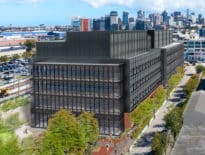
Boston’s current lab construction pipeline includes 5.8 million square feet of projects already under construction, and more major developments are planned. In July, a development team led by Lincoln Property Co. received approval for a 650,000-square-foot lab tower at 701 Congress St. in Boston. Image courtesy of Arrowstreet, Moody Nolan and Studio Enee
Gone are the days when sizeable blocks of space in life science hubs from Kendall Square to the suburbs were all but impossible to find unless a company committed to leasing space years in advance of completion.
Shocks to financial markets and caution by funding sources have changed the real estate equation in the Greater Boston life science cluster, after nearly a decade of constant growth and absorption. Local firms have laid off more than 1,100 employees in 2021, venture capital funding and IPO activity is down, and sublease availabilities more than doubled in the second quarter to 916,000 square feet.
“In 2021, it was an absolute feeding frenzy,” said John Coakley, life science principal for tenant advisory brokerage Cresa. “There was no space available, and there was a ton of demand. The tone out there in the market has changed, and demand is down a little bit.”
Record flows of venture capital funding to life science companies in 2021 have declined, and square-footage requirements have dropped by about 50 percent in the past year, according to local commercial brokerage data.
In the near term, Greater Boston’s leading position as the leading U.S. life science cluster appears secure. The availability rate across the region’s 33 million-square-foot lab market – stretching from Boston to Worcester – stood at just 2.4 percent in June, according to JLL research, including a 1.1 percent direct vacancy rate.
Local firms continue to receive healthy infusions of venture capital funding, a frequent catalyst for growth-stage companies’ search for additional real estate. VC funding to local firms totaled $5.6 billion in the first half of 2022, according to JLL, down 30 percent from the record-setting levels of 2021, when area companies raised a total of $15 billion.
Mark Bruso, senior research manager for JLL Boston, said active requirements have declined from nearly 7 million square feet to 3.5 million square feet in the past year. And the scale of requirements has shifted to opposite ends of the space spectrum.
“Those really early-stage companies are out there and there’s actually space for them to [lease] right now,” Bruso said last week during a commercial real estate webinar sponsored by Banker & Tradesman. “They’re the most active segment of the market right now. But there’s been a bit of a hollowing out of the middle, and all of that can be attributed to the difficulty of these mid-stage companies getting those second and third [venture capital] rounds.”

Venture capital funding for local biotechs has shrunk 30 percent from last year’s record-setting levels.
Full building leases by major pharmaceutical companies contributed to nearly 1.4 million square feet of positive absorption during the quarter, with AstraZeneca and Takeda Pharmaceuticals committing to future Kendall Square developments by Boston Properties and BioMed Realty, respectively, and Sanofi occupying its new 530,000-square-foot research campus at Cambridge Crossing. Total vacancies remained a modest 3.6 percent, and another 1.7 million square feet of deals are in negotiation but not finalized, according to JLL.
So, it’s no surprise that commercial developers continue to play the lab card as their best bet for virtually every development site in the urban core and many suburban markets that have suitable zoning and site characteristics.
Space Swaps Don’t Guarantee Discounts
While lab space contains more specialized layouts and equipment for companies’ specific needs, a sizeable portion of the sublease space has yet to be occupied and can accommodate a change of tenant, Coakley said. During 2021, many companies leased more space than needed for immediate expansion, as a defensive measure reflecting the tight market.
“That’s not a new concept but it was happening a lot more last year,” he said. “A lot of groups said, ‘I’m going to take 40,000 square feet and on day one I’m putting 10,000 out for sublease.’ I’ll have the opportunity to grow into it over time. But there’s definitely some groups that have put more [sublease] space than they expected.”
In some cases, asking rents for sublease space exceed direct rents, because life science companies place a premium on speed to occupancy, Coakley said.
The rise in sublease space does not directly affect landlords’ income, but adds new competition for landlords that are offering direct leased space, and could moderate future rent increases. It also raises questions about the projected amount of new construction and lab conversions that the local market can support in coming years.
Big infusions of brand-new lab space are already coming in the city of Boston, which appears on schedule to double its inventory of lab space by 2025. The current lab building boom will add 5.8 million square feet of inventory, according to JLL data, with the vast majority of activity taking place in the Seaport District and Fenway.
Uncertainty About Long-Term Pipeline
The picture is cloudier for life science projects scheduled for completion after 2024, many of which are still in permitting or preconstruction. Active requirements have declined more than 50 percent from last year’s peak, according to Newmark data. And IPO activity has slowed amid the stock market’s retreat, with only eight Bay State biopharma companies going public in the first half of 2022.

Steve Adams
Vacancies in the 13 million-square-foot Cambridge lab market have increased from 1.2 percent to 2.2 percent in the past year, according to Newmark research.
Liz Berthelette, director of research for Newmark in Boston, predicts that nearly two-thirds of the 40 million square feet of permitted and proposed life science projects in Greater Boston won’t get built, as supply catches up with demand and macroeconomic factors make projects more difficult to pencil. Many projects still seeking financing are at risk of being delayed or put on hold.
“Inflationary pressures, rising interest rates, rising costs of capital and debt and construction costs are all putting pressure on developers,” Berthelette said. “We don’t expect all of those projects to move forward in this development cycle.”







